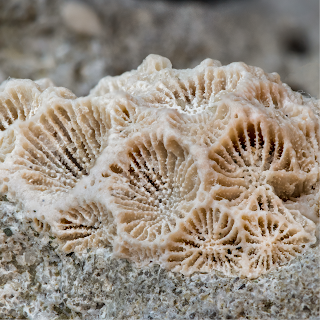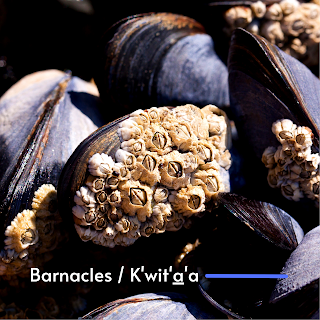 |
| Time Slows at Berlin-Ichthyosaur State Park |
Around half past five, as the first flush of dawn appears, our group was up and ready to visit a site that has been on my bucket list for some time.
High on the hillside up a long entry road sits the entrance to Berlin-Ichthyosaur State Park in central Nevada. It is a short 2-hour drive from our lodgings through orange-hued grasslands and low sloping hills.
A worn American flag and sun-bleached outbuildings greet you on your way to the outcrops. Away from the hustle and bustle that defines the rest of Nevada this place feels remarkably serene. Your eyes squint against the sun as you search for ammonoids and other marine fossil fauna while your nose tends to the assault from the bracing smell of sagebrush.
This site holds many stories. The interpretive centre displays wonderful marine reptiles, ichthyosaurs in situ, as you might expect from the name of the park — but it also showcases years of history lovingly tended. This stretch of dry golden low hills dappled with the yellow of creosote and desert grasses is an important locality for our understanding of the Carnian-Norian boundary (CNB) in North America.
The area is known worldwide as one of the most important ichthyosaur Fossil-Lagerstätte because of the sheer volume of remarkably well-preserved, fully articulated (all the sweet bones laid out all in a row...) specimens of Shonisaurus popularis.
Rich ammonoid faunas outcrop in the barren hills of the Upper Triassic (Early Norian, Kerri zone), Luning Formation, West Union Canyon, Nevada. They were studied by N. J. Silberling (1959) and provide support for the definition of the Schucherti and Macrolobatus zones of the latest Carnian — which are here overlain by well-preserved faunas of the earliest Norian Kerri Zone.
The genus Gonionotites, very common in the Tethys and British Columbia, is for the moment, unknown in Nevada. The Upper Carnian faunas are dominated by Tropitidae, while Juvavitidae are conspicuously lacking.
 |
Middle Triassic Ammonoids
|
Despite its importance, no further investigations had been done at this site for a good 50 years. That changed in 2010 when Jim Haggart, Mike Orchard and Paul Smith — all local Vancouverites — collaborated on a project that took them down to Nevada to look at the conodonts and ammonoids. They did a bed-by-bed sampling of ammonoids and conodonts in West Union Canyon during October of that year.
October is an ideal time to do fieldwork in this area. There are a few good weeks between screaming hot and frigid cold. It is also tarantula breeding season so keep your eyes peeled. Those sweet little burrows you see are not from rodents but rather largish arachnids.
The eastern side of the canyon provides the best record of the Macrolobatus Zone, which is represented by several beds yielding ammonoids of the
Tropites group, together with
Anatropites div. sp.
Conodont faunas from both these and higher beds are dominated by ornate metapolygnthids that would formerly have been collectively referred to Metapolygnathus primitius, a species long known to straddle the CNB. Within this lower part of the section, they resemble forms that have been separated as Metapolygnathus mersinensis. Slightly higher, forms close to Epigondolella' orchardi and a single Orchardella n. sp. occur. This association can be correlated with the latest Carnian in British Columbia.
Higher in the section, the ammonoid fauna shows a sudden change and is dominated by Tropithisbites. Few tens of metres above, but slightly below the first occurrence of Norian ammonoids Guembelites jandianus and Stikinoceras, two new species of conodonts (Gen et sp. nov. A and B) appear that also occur close to the favoured Carnian/Norian boundary at Black Bear Ridge, British Columbia. Stratigraphically higher collections continue to be dominated by forms close to M. mersinensis and E. orchardi after BC's own Mike Orchard.
The best exposure of the Kerri Zone is on the western side of the West Union Canyon. Ammonoids, dominated by Guembelites and Stikinoceras div. sp., have been collected from several fossil-bearing levels. Conodont faunas replicate those of the east section. The collected ammonoids fit perfectly well with the faunas described by Silberling in 1959, but they differ somewhat from coeval faunas of the Tethys and Canada.
The ammonoid fauna paints a compelling picture of Tethyan influence with a series of smoking guns. We see an abundance of Tropitidae in the Carnian, a lack of Pterosirenites in the Norian, copious Guembelites, the Tethyan species G. philostrati, the stratigraphic position of G. clavatus and the rare occurrence of Gonionotites. Their hallelujah moment was likely finding an undescribed species of the thin-shelled bivalve Halobia similar to Halobia beyrichi — the clincher that perhaps seals this deal on Tethyan influence.
I'll take a boo to see what Christopher McRoberts published on the find. A jolly good idea to have him on this expedition as it would have been easy to overlook if the focus remained solely on the conodonts and ammonoids. McRoberts has published on the much-studied Pardonet Formation up in the Willison Lake Area of Northeastern, British Columbia. He knows a thing or two about Upper Triassic Bivalvia and the correlation to coeval faunas elsewhere in the North American Cordillera, and to the Boreal, Panthalassan and Tethyan faunal realms.
If you fancy a read, they published a paper: "Towards the definition of the Carnian/Norian Boundary: New data on Ammonoids and Conodonts from central Nevada," which you can find in the proceedings of the 21st Canadian Paleontology Conference; by Haggart, J W (ed.); Smith, P L (ed.); Canadian Paleontology Conference Proceedings no. 9, 2011 p. 9-10.
 |
Fig. 1. Location map of Berlin-Ichthyosaur State Park
|
Marco Balini, James Jenks, Riccardo Martin, Christopher McRoberts, along with Mike Orchard and Norman Siberling, did a bed by bed sampling in 2013 and published on The Carnian/Norian boundary succession at Berlin-Ichthyosaur State Park (Upper Triassic, central Nevada, USA) and published in January 2014 in Paläontologische Zeitschrift 89:399–433. That work is available for download from ResearchGate. The original is in German, but there is a translation available.
After years of reading about the correlation between British Columbia and Nevada, I had the very great pleasure of walking through these same sections in October 2019 with members of the Vancouver Paleontological Society and Vancouver Island Palaeontological Society. It was with that same crew that I'd originally explored fossil sites in the Canadian Rockies in the early 2000s. Those early trips led to paper after paper and the exciting revelations that inspired our Nevada adventure.
If you plan your own adventure, you'll want to keep an eye out for some of the other modern fauna — mountain lions, snakes, lizards, scorpions, wolves, coyotes, foxes, ground squirrels, rabbits, falcons, hawks, eagles, bobcats, sheep, deer and pronghorns.
Figure One: Location map of Berlin-Ichthyosaur State Park. A detailed road log with access information for this locality is provided in Lucas et al. (2007).




























.jpg)




.jpg)





